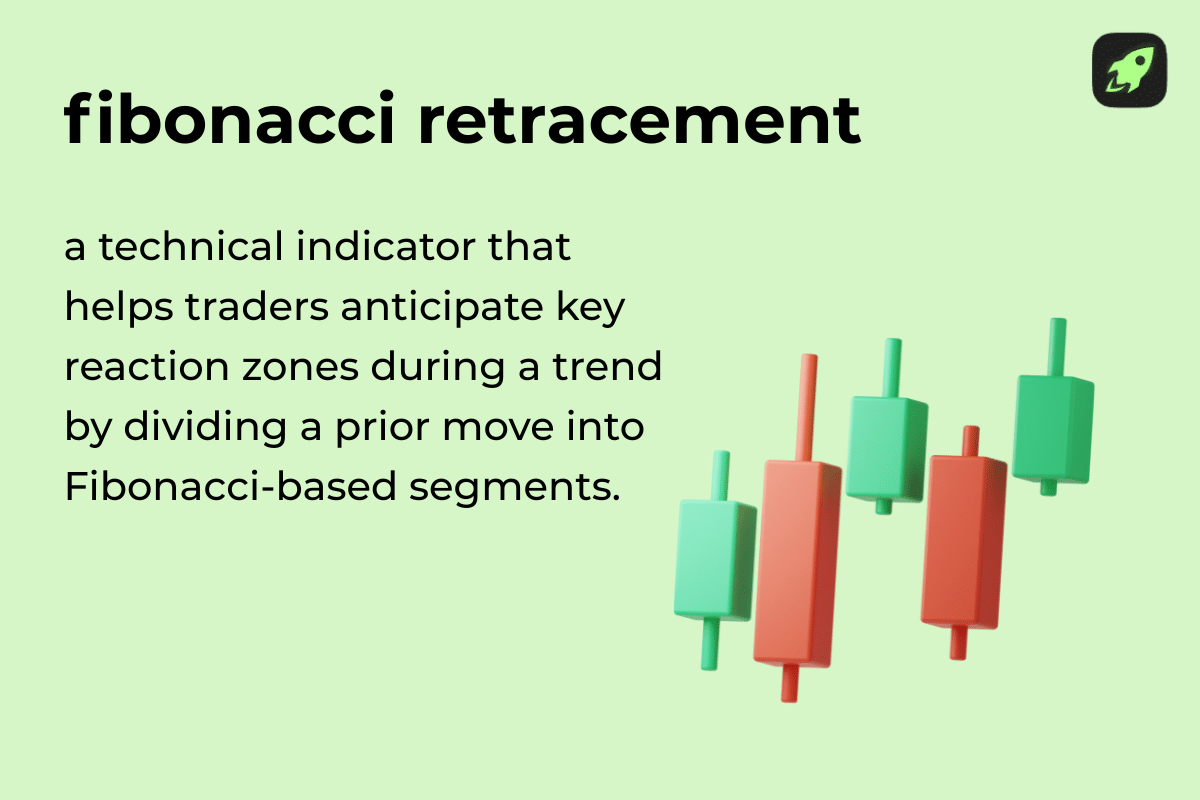Most traders know the pain of buying too early or exiting too late. Fibonacci retracement helps reduce that pain. It maps where trends tend to pause, helping you spot smarter entry zones and exit points. This guide will walk you through the method, tools, and signals that make Fibonacci one of the most useful tools in a trader’s kit.
Table of Contents
What Is Fibonacci Retracement?
Fibonacci retracement is a technical analysis tool that shows where price might pause or reverse during a trend pullback. It’s based on the Fibonacci sequence—a series where each number is the sum of the previous two. From it come key ratios like 23.6%, 38.2%, and 61.8%. Traders use these levels to mark potential support and resistance zones. Even 50% is often included as a psychological midpoint.
In crypto trading, Fibonacci retracement levels help you anticipate market reactions and plan trades with structure instead of guessing.

Key Levels Explained
In a Fibonacci sequence-based crypto strategy, certain retracement levels carry more weight than others—and for good reason.
Let’s break them down one by one, with examples and context:
23.6%
This is a shallow pullback. When price only retraces to this level before continuing the trend, it signals strength. Buyers are aggressive, and sellers barely get a chance to push back. You’ll often see 23.6% hold during parabolic moves or high-momentum breakouts. However, because it’s so shallow, it’s not the most reliable place to plan entries, since price can blow past it without much notice.
38.2%
This is the first truly useful retracement level for traders. It’s a common dip-buying zone in an uptrend. It signals that some profit-taking has occurred, but buyers still control the trend. If price bounces cleanly from 38.2%, it’s often seen as a sign of trend continuation. Pair it with a bullish candlestick or rising volume for stronger confirmation.
50%
Although it’s not a true Fibonacci ratio, the 50% level is widely used because of psychology. It’s a psychological midpoint—traders assume that if a move gives back half its gains, it may stabilize before resuming. In crypto, where price often moves in waves, 50% retracements are surprisingly common. Use it as a warning level: holding above 50% usually keeps the trend intact, while closing below may signal deeper correction.
61.8%
This is the golden ratio, and the most watched and respected level. It often marks a key bounce or rejection point, especially when paired with other signals. Many crypto traders place buy or sell orders here, and bots are programmed to watch it too. It forms the base of the “golden pocket” zone (61.8%–65%), where strong reversals often happen. If this level breaks decisively, it may mean the trend is losing steam.
78.6%
This is a deep retracement, close to a full reversal. When price pulls back this far, the original trend may be weakening or almost over. Sometimes it offers one last bounce before failure, but more often, a break of 78.6% leads to a retest of the original low or high. It’s risky to trade against the trend here without other confirmation.
100%
A full reversal. The entire move is erased. If price returns to its starting point, the trend is officially invalidated, and you should reassess the setup. At this stage, support or resistance has failed, and the market may be shifting to a new structure entirely.
Important: these retracement levels act more like zones than precise levels. Price might overshoot slightly before reversing, especially in the golden pocket between 61.8% and 65%. Don’t expect perfection to the decimal. Look for signs of hesitation, bounces, or wicks around these areas.
Because so many crypto traders and algorithms watch these key levels, they often become reliable places for price to react. That self-fulfilling nature is exactly why Fibonacci continues to work—not because of magic, but because everyone’s looking at the same lines.
How to Draw Fibonacci Retracement on a Crypto Chart
Tools You’ll Need
Most crypto trading platforms, like TradingView or Binance, offer built-in Fibonacci tools. You’ll find them it in the drawing section, often represented by a percentage or diagonal icon. Once selected, it draws horizontal lines across your price charts based on the move you select. These lines help visualize where price may pause or reverse during a pullback.
Identifying Swing Highs and Lows
To get accurate levels, you need a clear swing high and low point. These are the top and bottom of a price move. For example, if a token rallied from $1,000 to $1,600, the significant price points are $1,000 (low) and $1,600 (high). Use obvious pivot levels, not noise.
Price action should show strong direction: large candles, few wicks, and rising momentum. Avoid tiny corrections, as they won’t give reliable data. Spend time analyzing price movements before drawing anything.
Trending Markets Only
Fibonacci works best in trends. In an upward trend, price makes higher highs and higher lows. The opposite applies for downtrends. But if the chart is moving sideways, skip this tool. Market trend matters, so confirm direction with trend lines or momentum shifts. Crypto often produces sharp price movements, so wait for a clean leg before applying Fibonacci.
Drawing the Tool
Once your swing points are clear, use the Fibonacci retracement tool to connect them. In an uptrend, drag from the low to the high. In a downtrend, do the reverse. The tool automatically plots retracement levels like 23.6%, 38.2%, 50%, and 61.8%. These become visual markers for future support or resistance areas.
Using the Levels
Focus on how price behaves near key retracement zones. The most watched levels are 38.2%, 50%, and 61.8%. If needed, enable 78.6% in the settings. These levels help you plan trades, define risk, and time entries. If the move is large, switch to a log scale for a more accurate read.
A Tip
When lots of traders are watching the same levels, price reactions become more likely. That’s why accurate swing points and consistent analysis are key.

How to Get Free Crypto
Simple tricks to build a profitable portfolio at zero cost

How to Use Fibonacci Patterns in Your Trading Strategy
Step 1: Identify the Trend
Before anything else, confirm the market trend. Is price making higher highs and higher lows (bullish) or the reverse (bearish)? Don’t guess—use chart patterns like flags, wedges, or breakouts to support your read. A valid trend is the foundation for effective Fibonacci use.
Step 2: Mark Swing High/Low
Next, spot the critical points: a clear swing high and low point that define the recent move. These extremes give the tool its structure. Without a well-defined range, your levels won’t be meaningful. Zoom out if needed to find visible pivots.
Step 4: Wait for Price Reaction
After drawing, wait and watch for price reactions near the levels. Don’t jump in early. Common potential reversals happen at 50% or 61.8%, but every market move is different. A clean price retracement with a bounce may signal continuation. If not, the move might fail.
Always watch for potential trend reversals if price slices through the levels without hesitation.
Step 5: Confirm Entry with Other Indicators
Use technical indicators for backup. The relative strength index (RSI) can show if the asset is oversold or overbought. Combine that with moving averages or moving average convergence divergence (MACD) for stronger setups. Use momentum indicators to confirm if the trend still has fuel.
Step 6: Place Your Trade and Manage It
Define your entry and exit points in advance. Know your exit points and use a stop-loss if the setup fails. Smart entry and exit planning reduces emotional trading. Align your trade with realistic profit targets, and always determine price targets based on what the chart offers. Over time, these habits sharpen your trading skills and improve your odds.
Combining Fibonacci with Other Tools
Support and Resistance Levels
Fibonacci levels get stronger when they align with a traditional support and resistance levels theory. For example, if the 61.8% Fib retracement overlaps with a previous swing low, it creates potential support. This confluence increases the odds of a bounce.
You can also identify potential support by checking for past reactions. If price previously reversed from the same zone, it’s likely others are watching it too. Layering Fibonacci with historical levels builds more confidence in your trade setup.
Candlestick Confirmation
Price action matters. Don’t rely on Fib lines alone, look for confirmation. When price reaches a retracement level, check for candlestick patterns like hammers, doji, or engulfing formations.
Clear price reactions at these levels are a strong signal. If price bounces from 38.2% and forms a bullish engulfing candle, that supports a long entry. If it stalls at 61.8% with a bearish pattern, it may be time to short or exit.
Trend Indicators
Use trend lines and indicators to support your bias. For example, if price bounces at the 50% retracement and touches an upward trend line, that’s added strength. You can also check moving averages like the 50- or 200-day to see if they intersect key Fibonacci zones.
For deeper market analysis, combine Fibonacci with tools like Bollinger Bands or Ichimoku Cloud. When multiple methods point to the same level, it becomes a high-probability zone.
Volume Analysis
Volume tells you how committed the market is. If price reaches a retracement and volume spikes, it’s a meaningful reaction. If there’s no volume, the level might not hold.
Final Thoughts: Is Fibonacci a Good Trading Strategy?
Fibonacci retracement levels give structure to volatile markets. They help you define risk, spot entries, and react with logic. When you use Fibonacci with discipline and confirmation, it becomes a valuable tool in your arsenal.
Like all trading strategies, it’s not about perfection, but probability. Combine Fibonacci with solid planning and market context, and you’ll unlock more potential price targets without second-guessing every move.
FAQ
Can I use Fib retracement on any timeframe?
Yes, you can. This technical analysis tool works on all timeframes, from 1-minute charts to weekly views. That said, higher timeframes often give more reliable signals. In a 4-hour or daily chart, market trend is easier to define and less prone to noise. Always match your Fibonacci strategy to your trading style—short-term scalps or long-term swings.
What’s the difference between Fibonacci retracement and Fibonacci extension?
Fibonacci retracement measures how far price might pull back before continuing the trend. Fibonacci extension, on the other hand, predicts where the price might go next if the trend resumes. It helps set profit targets after a move has already started. Common Fibonacci extension levels include 127.2% and 161.8%.
You’ll find the Fibonacci extension tool in most charting platforms alongside the retracement option.
How do I know if price will respect the Fibonacci levels?
Look for price reactions like a bounce, rejection, or slowdown near the level. Also, check for overlapping support and resistance levels or resistance zones from prior market structure. Confirmation tools like candlestick patterns or RSI increase the chances of a successful trade. If price slices through a level with volume, it might not hold.
There’s never a guarantee, but clues help.
Is the 61.8% level always the best entry point?
Not always, but it’s one of the most watched. The golden ratio (61.8%) often marks a strong reversal zone, especially in trending markets.
Still, context matters. Don’t rely on 61.8 alone. Look for confirmation and align with the broader trend. Good entry points often show up at confluence zones. Always consider surrounding key points and overall price structure before taking the trade.
Can I use Fibonacci retracement for short trades (selling)?
Yes, you can. Just flip the tool, and draw from high to low instead of low to high. It helps identify areas where a bounce might fade. That’s where you look for short entries. Watch for a price retracement up to resistance, then look for potential trend reversals. Use resistance areas to time the trade and protect your risk.
Disclaimer: Please note that the contents of this article are not financial or investing advice. The information provided in this article is the author’s opinion only and should not be considered as offering trading or investing recommendations. We do not make any warranties about the completeness, reliability and accuracy of this information. The cryptocurrency market suffers from high volatility and occasional arbitrary movements. Any investor, trader, or regular crypto users should research multiple viewpoints and be familiar with all local regulations before committing to an investment.


